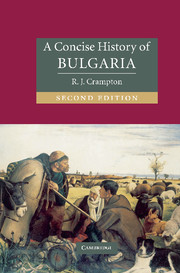Book contents
- Frontmatter
- Contents
- List of illustrations
- Preface
- Preface to the second edition
- Note on transliteration
- The Bulgarian lands: main rivers and mountains
- 1 THE BULGARIAN LANDS FROM PREHISTORY TO THE ARRIVAL OF THE BULGARIANS
- 2 MEDIAEVAL BULGARIA, 681–1393
- 3 OTTOMAN RULE IN THE BULGARIAN LANDS
- 4 THE NATIONAL REVIVAL AND THE LIBERATION
- 5 THE CONSOLIDATION OF THE BULGARIAN STATE, 1878–1896
- 6 FERDINAND'S PERSONAL RULE, 1896–1918
- 7 BULGARIA, 1918–1944
- 8 BULGARIA UNDER COMMUNIST RULE, 1944–1989
- 9 POST-COMMUNIST BULGARIA
- CONCLUSION
- Appendix 1 Bulgarian monarchs
- Appendix 2 Prime ministers of Bulgaria, 1879–2004
- Suggestions for further reading
- Index
- CAMBRIDGE CONCISE HISTORIES
1 - THE BULGARIAN LANDS FROM PREHISTORY TO THE ARRIVAL OF THE BULGARIANS
Published online by Cambridge University Press: 05 June 2012
- Frontmatter
- Contents
- List of illustrations
- Preface
- Preface to the second edition
- Note on transliteration
- The Bulgarian lands: main rivers and mountains
- 1 THE BULGARIAN LANDS FROM PREHISTORY TO THE ARRIVAL OF THE BULGARIANS
- 2 MEDIAEVAL BULGARIA, 681–1393
- 3 OTTOMAN RULE IN THE BULGARIAN LANDS
- 4 THE NATIONAL REVIVAL AND THE LIBERATION
- 5 THE CONSOLIDATION OF THE BULGARIAN STATE, 1878–1896
- 6 FERDINAND'S PERSONAL RULE, 1896–1918
- 7 BULGARIA, 1918–1944
- 8 BULGARIA UNDER COMMUNIST RULE, 1944–1989
- 9 POST-COMMUNIST BULGARIA
- CONCLUSION
- Appendix 1 Bulgarian monarchs
- Appendix 2 Prime ministers of Bulgaria, 1879–2004
- Suggestions for further reading
- Index
- CAMBRIDGE CONCISE HISTORIES
Summary
The lands which now constitute the state of Bulgaria were amongst the first in Europe to witness the emergence of organised, social life. Settlements existed in these lands as early as the middle palaeolithic period, from c. 100,000 to 40,000 bc. In neolithic times the population gradually forsook their caves for the plains where they began to work the land. By the third millennium bc they were cultivating non-food crops such as flax and had become adept at metal-working. In the sixth millennium bc an unknown people were producing objects of great originality and which experts consider to be the products of a spontaneously generated rather than an imported culture. This culture, in which the chief object of veneration appears to have been the mother goddess, reached its zenith in the fourth millennium bc.
By the end of the third millennium bc the lands to the east of the Morava–Vardar valleys were falling under the cultural influence of the Thracians. An Indo-European people, the Thracians lived in a loosely organised tribal society. They were masters of metal-working, particularly with silver and gold. Many spectacular hoards have been unearthed in present-day Bulgaria at sites such as Panagiurishte, Velchitrun and Vratsa, and many more remain to be excavated. In addition to a high level of proficiency in metal-working the Thracians were renowned for their horsemanship.
- Type
- Chapter
- Information
- A Concise History of Bulgaria , pp. 1 - 8Publisher: Cambridge University PressPrint publication year: 2005



